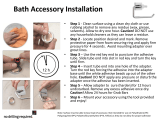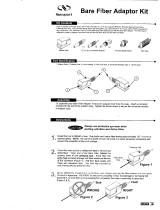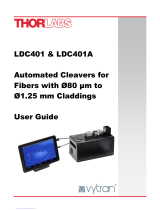
125 EUGENE O’NEILL DRIVE
NEW LONDON, CT 06320
TEL: 877-599-5393
FAX: 888-282-0043
INSTALLATION INSTRUCTIONS
,
LC ANAEROBIC STYLE CONNECTOR, SINGLE &
MULTI-MODE ON BUFFERED FIBER
INSTRUCTION SHEET # REV. ECN # SHEET DWN. BY: DATE CHK. BY: DATE APP. BY: DATE
71601488
01 03215
3 of 4
VSL 03/31/06 A.M. 04/03/06 RZ 04/03/06
Cleaving
tool
Exposed
fiber
Use
stroke to
score fiber
ONE
Connecto
ferrule
Type G
paper (green) wit
dull side up
NOTE: Proceed to the next step immediately
4.6 Insert the Bare Fiber Into the Connector and Attach the Buffer Support Boot
4.6.1 Immediately insert the bare fiber into the small tube inside the connector and carefully locate the hole in the ferrule, then
push the bare fiber through the ferrule. Slightly rotating the fiber while applying light force may ease this process.
4.6.2 Place the connector in a safe location and allow to cure for a minimum of one minute.
4.6.3 Remove the connector from the holder and push the buffer support boot onto the connector. Use the edge of a wipe to
remove any uncured adhesive from around the fiber.
4.7 Score the Fiber
4.7.1 Delicately place the cleaving tool provided in your kit down onto the top of the adhesive bead and up against the exposed
fiber. The objective is to cleave the fiber as close to the top of the adhesive bead as possible (do not attempt to cut the
adhesive bead). Position the cleave tool at approximately 45° for optimum results.
4.7.2 Using one stroke of the cleaving tool, gently score the exposed fiber by sliding the cleave tool across the bare fiber. The
cleave is designed to score the fiber, not actually cut it.
4.7.3 Remove the cleaved fiber by gently pulling it straight away or axially from the connector. If the fiber does not easily pull
off, score again 180° from the initial score.
4.7.4 Dispose of fiber remnants responsibly.
4.8 Remove the Fiber Stub
4.8.1 Hold the connector in one hand vertical with the fiber stub or ferrule tip facing upward.
Hold one sheet of Type G Polishing Paper (green) in the finger tips of the other hand,
with the dull side facing downward.
4.8.2 Position the polishing paper perpendicular to the connector axis and
with just the weight of the polishing paper (dull side) resting on the
fiber stub, polish the fiber stub in a circular pattern of approximately 1
inch. Continue polishing until the burr from the cleave is removed.
Completion is determined by feel and/or sound. When you begin to
polish, you can actually feel and/or hear the sharp cleaved end of the
glass against the polishing paper. As the burr is removed, the scratching sound is
reduced, and the circular pattern feels smoother. This may require approximately 6-10
revolutions.
4.9 Polish the Fiber End
4.9.1 Clean both sides of a full sheet of Type G Polishing Paper with canned air.
4.9.2 Saturate a wipe with isopropyl alcohol.
4.9.3 Obtain the 5 inch diameter Universal Polishing Pad (OR-60300166) and the LC Polishing Tool/Puck. Clean the
unmarked/shiny side of the pad and the polishing tool with the saturated wipe from step 4.9.2. Dry both with canned air.
4.9.4 Insert the LC connector ferrule tip into the polishing tool/puck.
4.9.5
Stack four (4), 3-mil mylar spacers (clear) on top of the rubber pad, then place one sheet of Type G Polishing Paper
(green), dull side up onto the mylar spacers (the 4 mylar spacers provide additional cushion for polishing).
4.9.6 Gently place the polishing tool and connector onto the polishing paper. Start with light pressure and use figure 8 strokes
that are approximately 2 inches high and 1 inch wide. The figure 8 stroke must be well rounded to ensure complete
removal of adhesive from the end of the ferrule. If you feel any drag between the fiber and the paper revert back to step
4.8. Using moderate pressure, polish the connector for 30 figure 8 strokes. Move to an unused section of the polishing
paper for each connector polished. Approximately 6 connectors can be polished on a single sheet of Type G Paper.
4.9.7 Using the microscope provided with your kit, inspect the ferrule tip for excess adhesive. Excess adhesive must not
surround the fiber, nor should there be any adhesive on the beveled edge of the ferrule. If excess adhesive is observed,
continue to use the Type G Paper until the excess adhesive is removed.
NOTE: This concludes the multi-mode polishing procedure, for single mode polishing continue on to step 4.9.8.
4.9.8 Remove the Type G paper and replace with a sheet of Type M Paper (white) over the 4 mylar spacers that are positioned
on the rubber pad.
4.9.9 Dampen the Type M Paper with distilled water (do not soak/flood). Remove the connector from the polishing tool and use
the tool (lightly) to distribute the water evenly over the paper. Replace the connector back in the polishing tool.
4.9.10 Using (10) 2 inch X 1 inch figure eight strokes as described in section 4.9.6, buff polish using moderate pressure.
4.9.11 Clean the fiber end with a wipe dampened with water, then clean a second time with a wipe dampened with alcohol.







